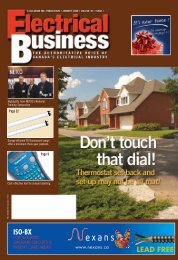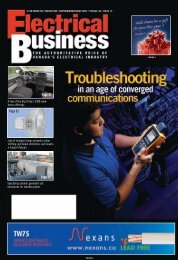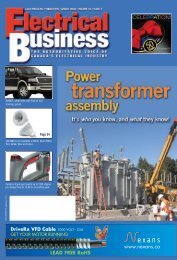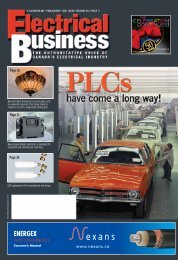September 2006.pdf - Electrical Business Magazine
September 2006.pdf - Electrical Business Magazine
September 2006.pdf - Electrical Business Magazine
Create successful ePaper yourself
Turn your PDF publications into a flip-book with our unique Google optimized e-Paper software.
From the Legal Desk<br />
Are ‘pay-when-paid’<br />
clauses valid<br />
more<br />
More<br />
solutions<br />
safety.<br />
for<br />
By Stephen Tatrallyay<br />
Iwould expect that most of you have either seen in a<br />
contract, or heard from a general contractor when<br />
you’ve gone looking for money, something to the effect<br />
of: “You’ll get paid when I get paid and not before”. I have<br />
been asked on several occasions whether this ‘pay-whenpaid’<br />
position has any merit and, like so many aspects of<br />
the legal world, the unfortunate answer is both “Yes” and<br />
“No”.<br />
The leading case on the subject of pay-when-paid clauses<br />
in Ontario is Timbro Developments Ltd. v. Grimsby<br />
Diesel Motors Inc. (a decision of the Ontario Court of<br />
Appeal from 1988). In that case, a subcontract contained<br />
a clause that essentially said that payments would be made<br />
not more than 30 days after submission date, or 10 days<br />
after certification or when the money was received by the<br />
general contractor from the owner (whichever came later).<br />
This clause was displayed prominently on the early pages<br />
of the subcontract (not buried somewhere in a supplementary<br />
general condition), and several sources have told<br />
me the clause was even printed in red ink on the GC’s<br />
purchase order form.<br />
The GC argued that since it had never received payment<br />
from the owner, it had no obligation to pay the sub, and<br />
the Court of Appeal agreed. The clause dealt with liability<br />
for payment as well as the timing thereof, and was clearly<br />
visible to the sub. Thus, the risk of non-payment was<br />
assigned to the sub and not the GC.<br />
Other courts in Ontario have followed Timbro. In Kor-<br />
Ban Inc. v. Piggott Construction Ltd., even though the<br />
clause was in smaller print than in Timbro and didn’t<br />
quite stand out as much, the Superior Court held in 1993<br />
that it had nonetheless been brought to the sub’s attention.<br />
In this case, the subcontractor’s lawyer argued that<br />
the clause interfered with his client’s lien rights, but the<br />
court disagreed, saying that nothing in the clause precluded<br />
a subcontractor from pursuing a lien, which is a right<br />
against the holdbacks in the owner’s hands.<br />
The court in both Kor-Ban and in a subsequent decision,<br />
Applied Insulation Co. v. Megatech Contracting,<br />
held that the effectiveness of the clause would be suspect<br />
when the GC itself had committed some act that resulted<br />
in the owner’s refusal to pay. When a GC fails to meet its<br />
obligations to the owner under their contract, resulting in<br />
damages or excess costs incurred by the owner, the GC<br />
cannot rely on the owner’s non-payment to refuse paying<br />
the subtrades.<br />
(No case has as yet directly addressed the issue of the<br />
contractual rights as between the GC and the sub when<br />
the GC claims it was the subtrade that caused the problem.<br />
However, if the clause were present, I suspect the<br />
court might be inclined to try all the issues together<br />
because of the overlapping facts and—only when it had<br />
had a chance to consider all the facts and arguments—<br />
make a ruling as to who owes what to whom.)<br />
Other cases show us that where one side is arguing<br />
that there was such an agreement, but there is nothing<br />
in writing, then the argument is unlikely to succeed. In<br />
Environs Landscaping Co. v. Kenaidan Contracting, a<br />
2001 decision of the Superior Court, there was a paywhen-paid<br />
clause in the subcontract, but the litigation<br />
concerned payment for a number of additional trees that<br />
had been orally ordered outside the scope of the subcontract.<br />
The court held that the oral agreement regarding the<br />
extra work was not subject to the pay-when-paid written<br />
provisions of the subcontract. The extra trees were totally<br />
separate to the subcontract, and there had been no<br />
suggestion at the time the extra work was ordered that<br />
the pay-when paid clause would apply.<br />
Most recently, in Pre-Con Inc. v. Carosi Construction<br />
Ltd., the court interpreted two internally inconsistent<br />
pay-when-paid clauses in one agreement and held<br />
that—notwithstanding the differences between the<br />
clauses—the subcontractor must have been aware that<br />
his agreement contained some clause of that sort.<br />
Whether he had a problem with the agreement’s contents<br />
or wished to dispute that they were, in fact, what<br />
he had agreed to, the sub was nonetheless responsible for<br />
clarifying the meaning of the clause prior to starting work.<br />
Outside of Ontario, however, the Timbro decision has<br />
not generally been followed. In Nova Scotia, for example,<br />
the decision of the Court of Appeal in Arnoldin<br />
Construction v. Alta Surety in 1995 favourably considered<br />
several American cases that have attempted to minimize<br />
the impact of pay-when-paid clauses. The court<br />
was also of the opinion that the clause had not been<br />
drawn to the sub’s attention because it was located on<br />
the back page of the contract.<br />
Although there is clearly a discrepancy between the decisions<br />
in Timbro and Arnoldin, the Supreme Court of<br />
Canada declined to grant leave to appeal in the Nova<br />
Scotia case, which means that courts in other provinces<br />
are free to choose whichever approach they prefer, at<br />
least until such time as the Supreme Court issues a<br />
definitive ruling on the matter. Meantime, be sure to<br />
read every contract carefully and pay particular attention<br />
to the parts explaining how you get paid.<br />
The material and information contained in this column<br />
is not a legal opinion. Always consult your own legal<br />
counsel for more specific interpretations.<br />
Stephen Tatrallyay has practiced construction law all over<br />
Canada since 1984, and is extensively familiar with the Courts of<br />
Justice Act, Rules of Civil Procedure, the Occupational Health &<br />
Safety and Construction Lien acts, as well as their respective<br />
forms and regulations. He is a founding fellow and past-president<br />
of the Canadian College of Construction Lawyers, and served<br />
as executive member and former chair of both the Ontario and<br />
National Canadian Bar associations, Construction Law Section.<br />
Tatrallyay is available for consultation on most matters pertaining<br />
to construction law<br />
Your<br />
P&S Safety Products — the innovative<br />
solutions your customers demand.<br />
Today’s homeowners and buyers are safety<br />
conscious, and willing to upgrade to get enhanced<br />
peace of mind at home. P&S Tamper-Resistant<br />
Receptacles, LED Hallway Lights and Home<br />
Locator Switches deliver exactly what your<br />
customers are looking for — and provide new<br />
opportunity to help you grow your business.<br />
Get all the details from your P&S distributor —<br />
or visit www.passandseymour.com/safety<br />
see<br />
www.passandseymour.com/safety<br />
©2006, Pass & Seymour/Legrand<br />
customers want<br />
style,<br />
not<br />
P&S Screwless Wall Plates — the smooth,<br />
elegant look today’s homeowners crave.<br />
Visible screws detract from the smooth style your<br />
customers are looking for. P&S Screwless Wall<br />
Plates give them exactly what they want, without<br />
the dirt-catching channel that’s on competitors’<br />
products. And you get a sturdy, easy-to-install<br />
design. Get all the details from your P&S<br />
distributor — or visit www.passandseymour.com<br />
www.passandseymour.com<br />
©2006, Pass & Seymour/Legrand<br />
to<br />
screws.<br />
INFO NO. 12 INFO NO. 11<br />
Legrand_EB_Sept2006 1<br />
www. mag.com • SEPTEMBER 2006 • 13<br />
8/16/06 9:58:23 AM

















